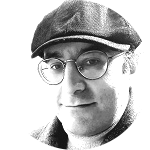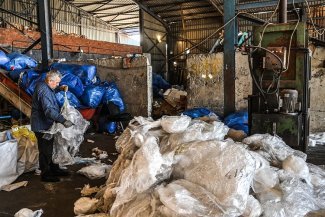

There is still no long-term solution to the problem of radioactive waste and the threat it poses. In this photo from November 2016, Greenpeace is staging a protest pressing for the Almaraz plant to be closed, as scheduled, rather than extending its life.
Thirty one years after the nuclear accident at the Chernobyl plant in Ukraine, and just six since the disaster at the Fukushima plant, which is still pouring 300 tonnes of radioactive water into the Pacific Ocean every day, there are more than enough reasons for the eternal debate over the reliability and safety of nuclear power to be as heated as ever.
After being in operation in Europe for half a century, there is no doubt as to the perils of ageing installations and the need to store ever-growing amounts of radioactive nuclear waste, which will continue to pose a threat to life for hundreds of thousands of years.
Twenty seven per cent of the electricity produced in the European Union comes from the 128 nuclear reactors operating in fifteen member states. And according to the trade association for the nuclear energy industry in Europe, FORATOM, another hundred will have to be built between 2025 and 2045 to maintain current generation capacity, at least, until 2050 .
As European states and electricity companies discretely work towards this objective, a long-term solution has yet to be found to the issue of radioactive waste and the threat it poses, despite the strong public resistance to storage facilities in the areas affected.
Two very current cases illustrate the situation perfectly. Firstly, the nuclear waste storage facility that Madrid made plans to build, without consulting Lisbon, next to the ageing Almaraz power plant in the province of Cáceres, barely a hundred kilometres from the Portuguese border and which Portugal has appealed against to the European Commission. The issue has not yet been resolved.
Secondly, the huge permanent underground repository that Paris is planning to build to store its long-lived, high-level radioactive waste for thousands of years, a project on an unprecedented scale. The dump is to be located in the village of Bure, in the Lorraine region of northeast France, despite unyielding opposition from local residents.
Almaraz, the key to Spain’s nuclear future
The Almaraz case – in which Spain violated the Espoo Convention, which obliges it to consult Portugal on any nuclear project with potential environmental implications for its neighbouring country, such as the radioactive waste facility – started to move forward in February, when Brussels obliged Madrid to suspend its unilateral decision to build the facility, pending an agreement with Lisbon and a report on the matter by the Espoo Convention Implementation Committee, to be submitted in August.
What is at stake in Almaraz is not only the construction of a nuclear waste storage facility, which will have to be done sooner or later to store the radioactive waste already produced by this Spanish plant, which supplies almost a quarter of the nuclear power on the Iberian Peninsula (Portugal does not produce nuclear power).
“The big question surrounding this nuclear waste storage facility is, what is it being built for? Is it to dismantle the plant or to extend its life?” asks the spokesperson of Greenpeace Spain’s anti-nuclear campaign, Raquel Montón, in an interview with Equal Times.
The first reactor has a licence to operate until June 2020, when it will be 40 years old, and a storage facility will have to be built to enable the plant’s closure. However, as Montón points out, “The fact that it is being built ahead of time would imply that its purpose is to extend the plant’s operating life, as the fuel pools do not have the capacity to accommodate spent materials beyond the 40-year mark.” A new storage facility would have to be built before 2020, if the intention is to keep the plant in operation.
“The strategy to extend the life of nuclear plants is no secret. It is a plan the [Spanish] government is already implementing and has spoken about publicly, on more than one occasion,” recalls Montón. She warns that “the way the rules are being ‘adapted’ so that the life of plants can be extended also implies increased risks,” as the conditions required to authorise them are lowered. It was similar slackness that led to the Fukushima accident, which was the result of combined laxity on the part of Japan’s government, its regulators and the operating company TEPCO.
In the case of Almaraz, the latest in the list of incidents at the plant over recent years was on 10 April, when a reactor stoppage took place due to a simple electrical problem. Like Fukushima, the plant lacks the pressure relief valves required to prevent a hydrogen explosion. “The safety protocols are met, but that is not enough,” insists Montón.
“The system worked and the reactor stopped, but the problem is that a fault in the normal circuit ends up causing a reactor stoppage. It’s as if a Formula 1 car had to leave the circuit due to a minor problem, to avoid the driver having an accident: of course it has to be taken off the circuit, but neither Mercedes nor Ferrari can afford such faults.”
Although, according to the Massachusetts Institute of Technology (MIT), there is a 50 per cent chance of another accident like Fukushima in the next 50 years, or another Chernobyl in the next 27 years, “Europe has neglected the opportunity to apply vital protection measures, for example, against earthquakes, floods, hydrogen explosions, or to install adequate pressure relief valves to prevent the release of radioactive emissions into the environment in case of an accident,” insists Montón. Such valves could have prevented the radioactive contamination from Fukushima.
Bure, an unprecedented challenge
Meanwhile, France has, for decades, been preparing the Cigéo, a gargantuan underground facility, to be built in the village of Bure, where it intends to bury 80,000 cubic metres of radioactive waste. Although this amounts to just three per cent of the total, nationwide, it represents 99 per cent of the total radioactivity present in the country’s entire nuclear waste, due to its long-lived, high-level radioactivity, as local environmental organisations have highlighted.
France’s national agency for radioactive waste, ANDRA, which expects the first waste to arrive in Bure by 2025, explains that it chose this site because of it geographic features and its 160 million-year-old rock, which should offer, in theory, better containment guarantees than other soils when its comes to accommodating an underground warehouse for thousands of years. But the local population is aware that this also implies installing chimneys that will continually emit gases with radioactive isotopes.
Aside from the immediate environmental reasons, “one of the great perils may also come from geopolitical changes,” Marie Colline, a member of Bure Zone Libre, the association resisting the nuclear dump, tells Equal Times.
“A century ago, in this very place, the First World War was fought. We are 80 kilometres from Verdun, and the site where the military waste from the war was buried, and that continues to pollute our fields and rivers to this day, has been wiped from the collective memory for quite some time already,” she explains. For that very reason, a project on an unprecedented scale like Cigéo is “too risky” she adds, as “no one can commit to its upkeep” and there is no clear answer as to how to ensure the “burial site” will be kept safe for centuries to come.
The few similar attempts made up until now are far from convincing, insists Colline. “The explosions at the WIPP [Waste Isolation Pilot Plant, in New Mexico, United States, in 2014], collapses in Asse [where former salt mines were used to store nuclear waste as part of a German research project that ended in 1995].” And now there are fears over the “contamination of rivers and groundwater in Russia”, which has just opened a similar tunnel in Novouralsk, on the eastern side of the Urals.
She nevertheless acknowledges the almost philosophical dilemma posed by the fact that, despite Bure Zone Libre’s slogan calling for there to be no Cigéo “not here, not anywhere,” there is no escaping the need to store already existing radioactive waste.
“The solution of burying the waste is a bad one, but the state and the nuclear industry don’t seem to be looking for an alternative, and that’s frightening if you think about the future. That small number of people who make decisions on their own for the rest of the planet, need to do a bit more philosophy!” she concludes.









